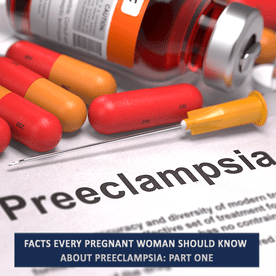Each year almost eight hundred pregnant women die in the U.S. and frequently from undiagnosed preeclampsia. May is Preeclampsia Awareness Month and the Smart Mother’s Guide will be presenting strategies and tools to reduce maternal mortality as it relates to preeclampsia, so let’s begin.
Preeclampsia is a clinical condition that occurs during pregnancy and involves high blood pressure, protein in the urine and swollen areas of the body that can include the legs, ankles, feet and sometimes face. However, one does not need to have all these symptoms at the same time in order to be diagnosed with preeclampsia. Unfortunately, preeclampsia is sometimes misdiagnosed during pregnancy which, if left untreated, could cause a stroke, very low platelets, seizures and death. Although preeclampsia usually occurs in the late 2nd or early 3rd trimester, it can occur any time after twenty weeks and yes, it IS possible to be diagnosed with preeclampsia as early as twenty-two or twenty -three weeks.
Fact: If you have never had high blood pressure before becoming pregnant but now have a blood pressure reading of 140/90 or greater mmHg on at least two occasions at least four hours apart) and proteinuria after 20 weeks of gestation, you have preeclampsia. What does this mean?
If preeclampsia is suspected and you are sent to the hospital, no one should send you home before 4 hours of testing and monitoring. When patients reach the hospital and are placed on their left side, the blood pressure may improve and the patient is sent home prematurely with a false sense of well-being, only to return hours later or maybe a day or two later with severe symptoms of preeclampsia. Therefore, please remember the four-hour rule: if you present to the hospital with a blood pressure of 140/90 or greater, no one should send you home after just one blood pressure reading and the second should be done four hours later unless you are manifesting symptoms of severe preeclampsia.
If you found this information helpful, please share and stay tuned for Part Two of this series.
…..
Follow Dr. Linda on Facebook | Order your copy of The Smart Mother’s Guide to a Better Pregnancy: How to Minimize Risks, Avoid Complications, and Have a Healthy Baby | Dr. Linda is a board certified Ob/Gyn and an expert in the area of pre-eclampsia and high-risk pregnancies. Contact Dr. Linda about an appearance at your next event or media placement opportunities.
Copyright thesmartmothersguide.com. Duplicating this content in entirety without written permission is expressly forbidden.




